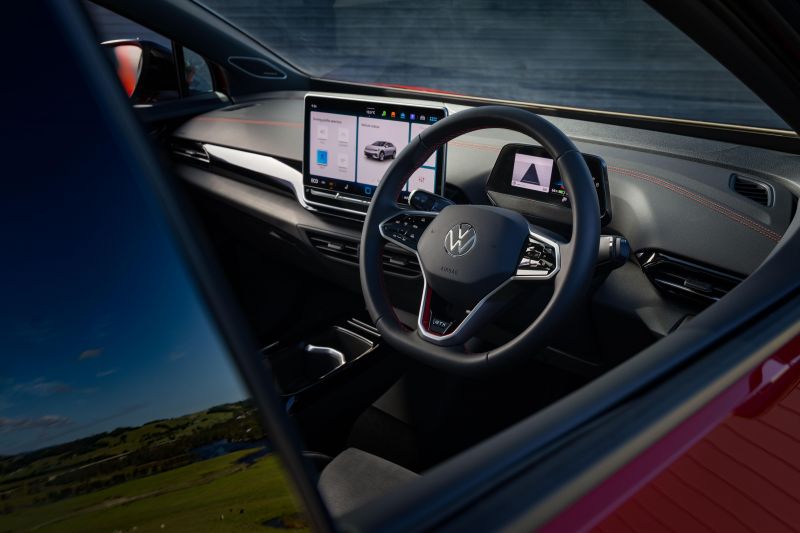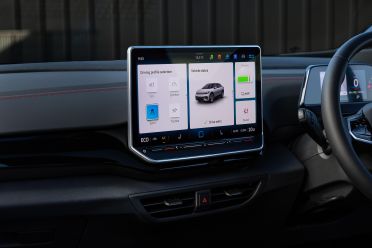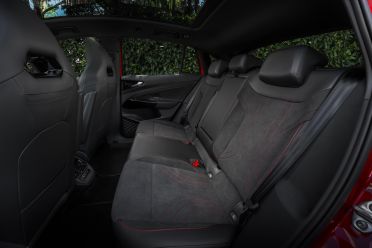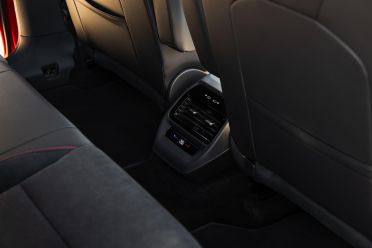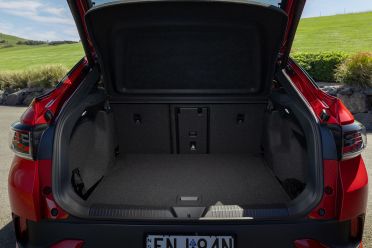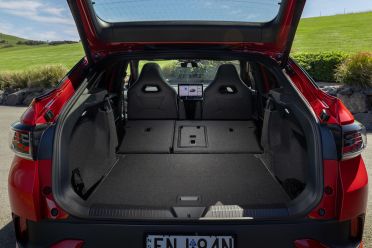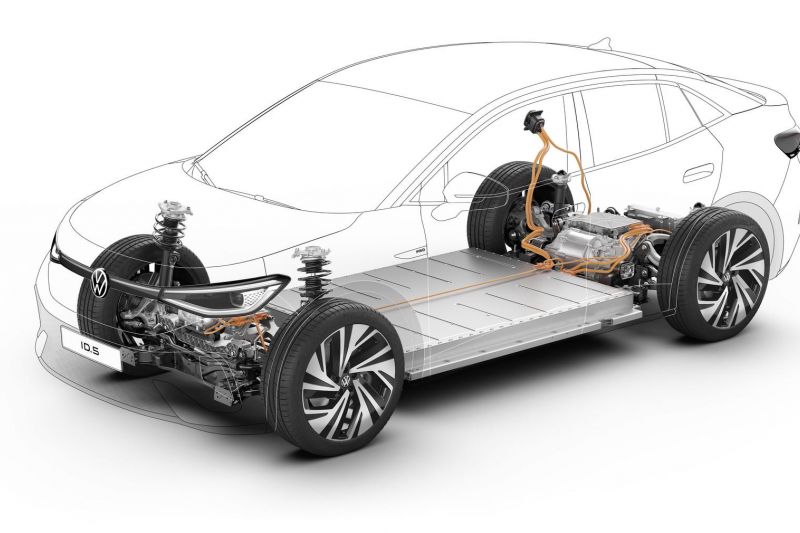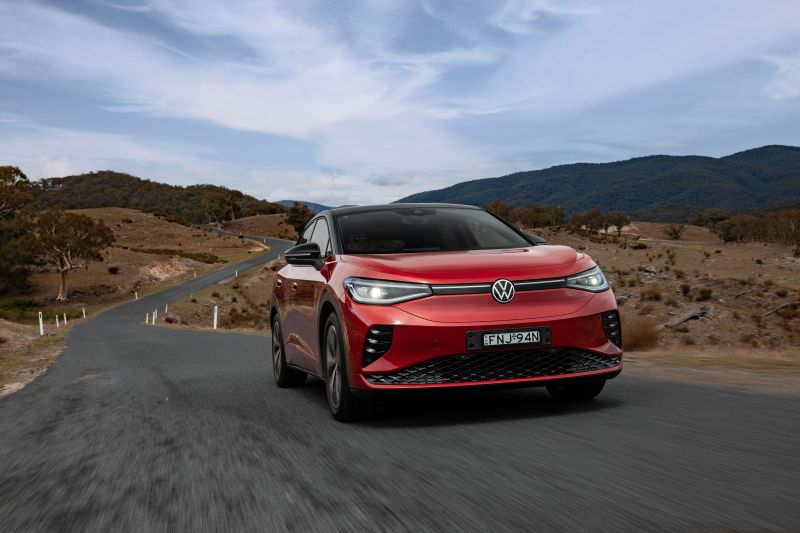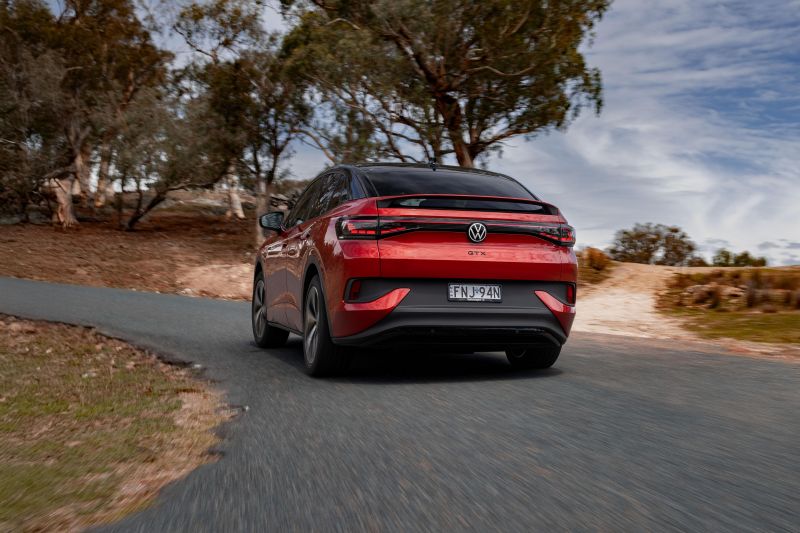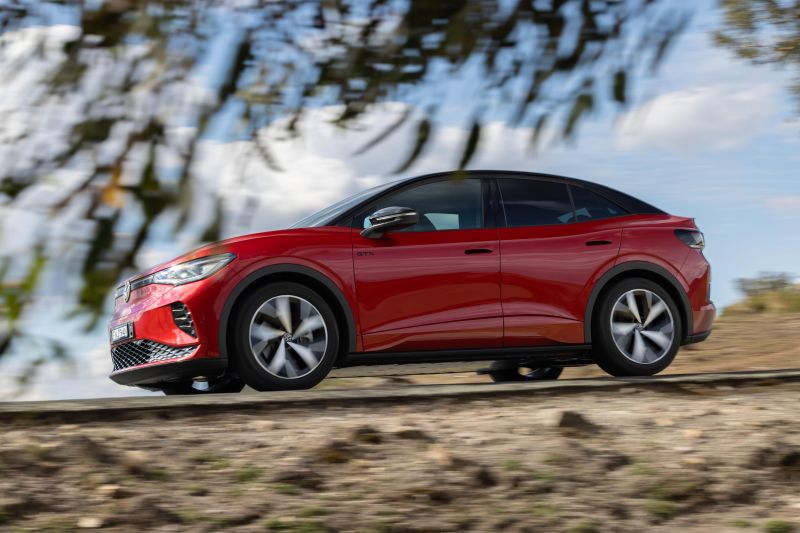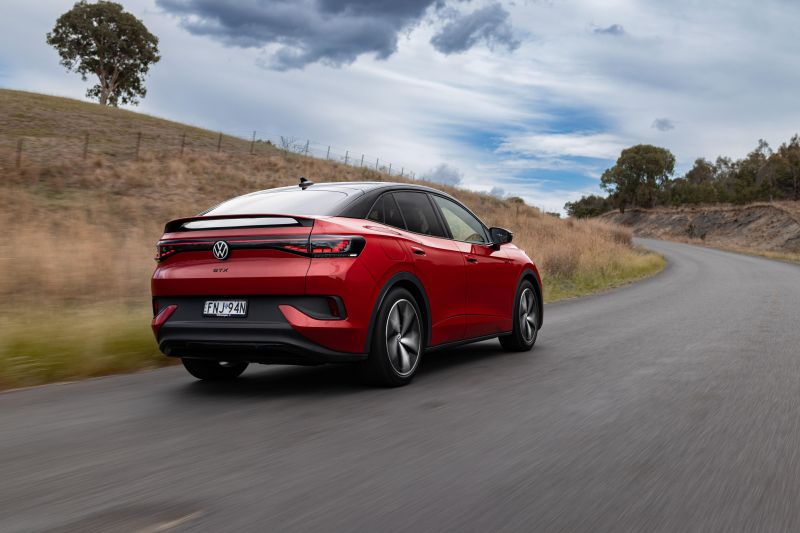Volkswagen Australia has gone from having no electric SUVs in its range to releasing two brand-new ones simultaneously in the hottest sales segment, with the arrival of the new Volkswagen ID.5.
Not only is the 2025 Volkswagen ID.5 GTX spearheading VW Passenger Vehicles’ EV rollout in Australia, it’s also the first coupe-style SUV from the German brand to make it Down Under.
For a long time the SUV ‘coupe’ trend was limited to premium and luxury brands – think BMW and Mercedes-Benz – but we’re seeing more of this form factor in the volume segments now, with Renault and Chinese brands like GWM leading the charge.
The ID.5 is exactly what it looks like: a sleeker version of the ID.4 with which it shares its MEB EV platform with. It’s launching solely in dual-motor, all-wheel drive performance-oriented GTX trim, though a more attainable ‘Pro’ variant fitted with the ID.4 Pro’s single-motor electric drivetrain is coming later this year.
WATCH: Paul’s international drive review of the 2024 Volkswagen ID.4 GTX
VW Australia has taken a lot of bullets for being so late to the EV party, and while it’s beyond fashionably late the delay has allowed the German brand’s local division to negotiate much sharper pricing with its global parent, and position its new products in the thick of key competition.
The ID.4 Pro, for example, is as affordable as the Chinese-built Tesla Model Y RWD despite hailing from Zwickau, Germany. And the ID.5 GTX is a similar story in being within reach of the Model Y Long Range AWD and even the related Cupra Tavascan VZ with the same drivetrain – both assembled in China rather than Europe.
What does that mean? Well European-made cars are subject to import tariffs in Australia, unlike rivals made in various Asian nations. Further, we are getting the latest iterations of both the ID.4 and ID.5, which benefit from a number of upgrades to the powertrain, batteries and software.
The ID.4 and ID.5 are going hard on value rather than being outright ‘cheap’, blending the European brand’s refined and mature on-road manners with the same infotainment and driver assistance tech you’ll find in a VW Golf or Tiguan.
In the case of the GTX, it debuts the new performance vehicle badging of the ID range, which claims to bring the ‘essence of GTI’ with it.
Does it deliver on those fronts? Mostly yes – read on to find out why.
How does the Volkswagen ID.5 compare?
View a detailed breakdown of the Volkswagen ID.5 against similarly sized vehicles.

Volkswagen
ID.5
How much does the Volkswagen ID.5 cost?
The GTX is the sole ID.5 variant available for now, alongside the ID.4 Pro wagon, and is priced from $72,990 plus on-road costs. A more affordable ID.5 Pro will be released in the latter stages of 2025, likely priced in the low-$60,000 bracket.
-
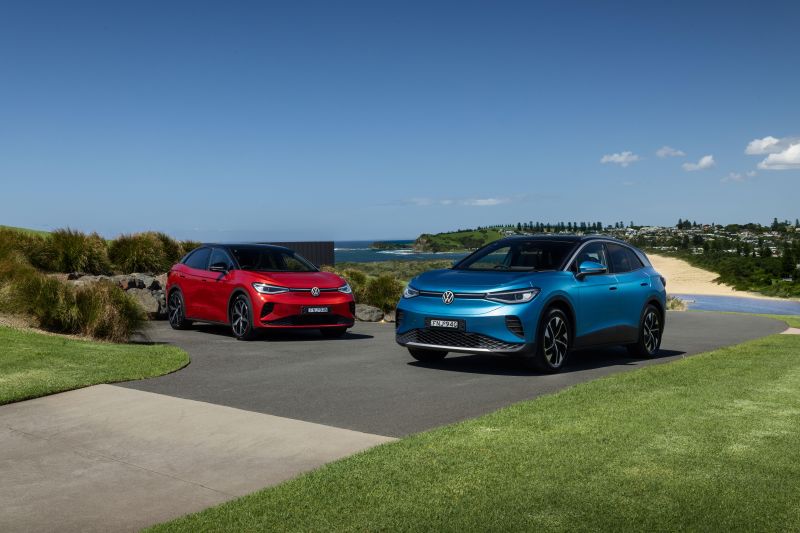
ID.5 GTX and ID.4 Pro
| Model | Price before on-road costs |
|---|---|
| 2025 Volkswagen ID.5 Pro | $TBC |
| 2025 Volkswagen ID.5 GTX | $72,990 |
The ID.5 GTX commands a $13,000 premium over the ID.4 Pro, though the ID.4 GTX due later this year will likely only be about $3000 cheaper – thanks to its coupe ‘tax’.
While the ID.4 Pro is very competitively priced against key players, the ID.5 GTX is a more premium proposition and aligned with the Tesla Model Y Long Range AWD ($68,000) and BYD Sealion 7 Performance AWD ($63,990), as well as rivals within the VW Group umbrella such as the Cupra Tavascan VZ ($74,490) and Skoda Enyaq Sportline ($69,990).
To see how the Volkswagen ID.5 lines up against its rivals, check out our comparison tool
What is the Volkswagen ID.5 like on the inside?
Just like the ID.4 Pro we also tested at the recent local launch, but with sportier trimmings – queue red stitching and black suede all around.
Apart from the colour scheme, the main differentiators between the GTX and the Pro are the Sport front seats with integrated head restraints, similar to the seats you’ll find in the latest Golf GTI hot hatch.
Soft-touch surfaces on the doors and dash including stitching details on the latter elevate the ambience, and as standard there’s front seat heating, as well as full electric adjustment with lumbar support.
Even better, there’s a massaging function and you also get fold-down armrests like in a Range Rover! The added bolstering of the Sport pews offer better lateral support especially during more spirited driving, which was a key takeaway after driving the ID.4 Pro and ID.5 GTX back to back on the Australian media launch.
It’s easy to find a comfortable driving position with a wide range of adjustment both in the seats as well as the steering wheel, and once you’re perched you have a pair of displays keeping you informed.
Unlike some rivals like Tesla, Volkswagen has retained a driver’s instrument cluster of sorts. The small 5.3-inch Digital Cockpit is familiar from other vehicles based on the MEB platform like the Cupra Born and Skoda Enyaq, with simple but clear readouts for speed and driver assistance features, as well as trip computer information.
Speaking of the Enyaq – currently on sale in Australia exclusively in Coupe form – I would argue that the larger Skoda feels more premium inside despite VW’s efforts to spruce up the cabin with nicer touches as part of the ID.4/ID.5’s midlife update.
Sadly, the augmented reality (AR) head-up display available overseas isn’t offered in our market, and as we know from the related Enyaq it would be a worthwhile inclusion. The fiddly touch capacitive steering wheel controls are another ergonomic faux pas in my book, as they can often result in mis-presses and get grimy with finger prints.
The 12.9-inch touchscreen runs an updated interface compared to earlier models sold overseas, and brings updates like always-on HVAC shortcuts and illuminated touch sliders. They all sound like small things, but they are a big improvement on the previous iteration which has been available in the Golf locally.
While everything worked fine during our launch drive, there are a couple of niggles. The lack of embedded navigation like other VW models is a shame, and is a common issue with MEB-based models as this feature is tied to connected vehicle hardware that isn’t offered locally.
You also don’t get wireless Apple CarPlay and Android Auto, at least from launch, meaning a USB-C cable is required to hook up your phone.
VW says it’s working on a retrofit solution like the ID. Buzz vans for early deliveries, though the company assures us that Wireless App-Connect will be standard from April production onwards, meaning most vehicles from the second half of 2025 will be delivered with it standard.
Storage up front is also decent thanks to the minimalist and open plan design. There’s a long centre console with cupholders, USB-C ports and a wireless smartphone charger, all covered by a sliding lid. Ahead of that, there’s a divided storage cubby in the gloss black-trimmed section – mind those scratchy keys!
Large door bins come with felt lining at the base to minimise rattling of bottles and other loose items, and they’re deep enough to carry big bottles.
The panoramic sunroof lets heaps of light in but also has an electronically operated shade, which is handy given a lot of other EVs do without a shade and that isn’t ideal in Australia’s hot sun. You can even use the IDA digital assistant to open it for you or toggle it via the climate controls.
Rear seat space is good for even larger adults.
I’m 6’1″ and can sit comfortably behind my preferred driving position with plenty of leg, knee and head room to spare – despite the ID.5’s sloping roofline and standard panoramic sunroof. It’s a little tapered compared to the ID.4, but still good.
The wide and flat rear bench seat allows you to squeeze three in across at a pinch, and the flat floor means you won’t be playing footsies if you’re sat in the rear-centre seat – though the console juts out a little into your footwell.
Other amenities include a third zone of climate control with directional air vents at the rear of the centre console, map pockets behind both front seats as well as smartphone pockets, and fold-down rear-centre armrest and decent-sized door bins as well.
As you’d expect, there are also ISOFIX child seat anchors on the outer rear seats as well as top-tether points behind each rear pew as well. You also get a ski port if you need to transport erm… skis… as well as other longer items.
Behind the second row Volkswagen quotes 549 litres of boot space with the rear seats in place, which expands to a healthy 1575 litres with them folded – curiously that’s slightly more than the ID.4 in both layouts. For reference, the outgoing Tiguan SUV quotes up to 615 litres with the rear seats slid forward, and 1655 litres with them folded.
While the ID.4 and ID.5’s combustion-powered stablemate has a space-saver spare wheel under the rear floor, VW’s electric SUVs make do with a tyre mobility kit instead – something to consider if you head out of town often.
| Dimensions | Volkswagen ID.5 GTX |
|---|---|
| Length | 4584mm |
| Width | 1852mm |
| Height | 1607mm |
| Wheelbase | 2769mm |
| Boot capacity | 549 litres – seats up 1561 litres – seats folded |
To see how the Volkswagen ID.5 lines up against its rivals, check out our comparison tool
What’s under the bonnet?
GTX versions of the ID.4 and ID.5 get a dual-motor electric drivetrain with a slightly bigger 79kWh (net) li-ion battery.
| Specifications | Volkswagen ID.5 GTX |
|---|---|
| Drivetrain | Dual-motor electric |
| Battery | 79kWh – net Lithium-ion |
| Power | 250kW |
| Torque | 134Nm – front 545Nm – rear |
| Drive type | All-wheel drive |
| Weight | 2256kg – tare |
| 0-100km/h (claimed) | 5.4 seconds |
| Energy consumption (claimed) | 17.0kWh/100km |
| Energy consumption (as tested) | 18.5kWh/100km |
| Claimed range | 522 kilometres – WLTP |
| Max AC charge rate | 11kW |
| Max DC charge rate | 175kW |
Our indicated efficiency figure was achieved over largely high-speed country roads and the Hume Highway heading to Wagga Wagga, hardly where any EV is going to be its most efficient.
As we saw in the ID.4 Pro on the same launch event, more suburban city driving will allow you to easily better the manufacturer’s consumption claim.
We didn’t get a chance to test the DC fast-charging capabilities, so we’ll have to do so when we get one through the garage.
To see how the Volkswagen ID.5 lines up against its rivals, check out our comparison tool
How does the Volkswagen ID.5 drive?
Given the long list of similarities between the ID.4 and ID.5, what really separates the launch models is the drive experience – and the ID.5 GTX is definitely my pick in this regard.
VW really harped on about how the GTX feels like a big GTI on the road, and while I was a touch skeptical about a 2.2-tonne electric SUV’s ability to drive like a Golf hot hatch, I was pleasantly surprised with how much I enjoyed it.
Mind you, I drove my personal Mk7.5 Golf GTI to the airport ahead of this launch, and what I love about it most is its ability to adapt to just about any driving scenario, such is the level of adjustability and all-round competence of that car.
Well, the ID.5 GTX may not present like a GTI in physical form, and nor does the vehicle’s weight or AWD really paint it in the same way, but it all comes together beautifully on just about any road.
Our launch drive of the ID.4 and ID.5 took us from the outskirts of Canberra into regional New South Wales, with a variety of patchy B-roads, country highways and everything in between.
From the get-go you can feel the more athletic and dialled-in nature of GTX package, with sharper responses to almost every driver input regardless of the drive mode selected. Like a GTI is to a regular Golf, everything feels that little bit tighter and more responsive.
It’s felt in everything from the throttle response to the steering and suspension performance, but by no means does this turn the ID.5 into a busy and jittery mess. If anything, it manages to be more resolved than the ID.4 Pro while also being more communicative.
The added power and grip from the dual-motor AWD system with 20:80 front-rear torque split means the smooth and effortless response of the single-motor ID.4 Pro is amplified with more thrust, reflected in the GTX’s 5.4-second 0-100km/h acceleration claim – 1.3s quicker than its single-motor equivalent.
Both from a standstill and on the roll, the ID.5 GTX accelerates with more verve and has more to give as the speed climbs. I did a couple of overtakes on regional NSW highways and was surprised how quickly the GTX built speed – minimal planning required here.
The progressive steering system is more feelsome and responsive than the ID.4, despite there being no obvious differences on paper, delivering both sharper response to inputs and better feedback.
With the tighter tuning of the Adaptive Chassis Control with its 15-stage adjustable dampers, the ID.5 GTX handles like a much smaller car than it is, giving you the confidence to really push it up or down a winding road. The unique Traction mode also ensures permanent all-wheel drive when activated, should you be driving on snow, gravel or other loose surfaces.
Larger 20-inch wheels with lower-profile 235/50 front and 255/45 rubber (versus 235/55 and 255/50 R19s on the ID.4 Pro) no doubt contribute to this marginally, though there was no discernible difference in road roar on some of the rougher surfaces we traversed.
In fact, both the ID.4 and ID.5 are very nicely insulated from the outside world, with minimal wind whistle or tyre noise. This isn’t always the case with EVs, given the lack of engine noise can amplify other ambient sound intrusion.
Fans of one-pedal driving modes will be disappointed to learn the ID.5 only offers minimal regen strength in D and a bit more in B, but there’s no proper one-pedal mode like in other EVs, if that matters to you.
If anything, it makes the ID.5 feel more like a normal car, or a hybrid with a subtle amount of energy recuperation.
Some will lament the rear drum brakes too, as I’ve seen many do in the comments sections of our reviews of other MEB cars. But to be frank, you probably won’t even notice them in normal driving given the front-end does the bulk of regen.
While we didn’t drag race the ID.5 GTX against the outgoing Tiguan like we did with the ID.4 Pro, I’d be interested to pit the dual-motor model against the incoming Tiguan 195TSI R-Line, as both offer all-paw traction and quote sub-6.0-second 0-100km/h acceleration times – something to consider for future tests, perhaps.
Finally, the assistance systems. Other than maybe the Model Y, the ID.5 offers some of the most user-friendly and intuitive active driver assists in the segment.
As in other Volkswagen cars, Travel Assist worked a treat in both the ID.4 Pro and ID.5 GTX, accurately keeping the cars in the centre of their lanes without yanking the steering out of your hands, and also accurately keeping a safe gap from leading traffic where appropriate.
The driver attention monitor barely makes itself known, and you don’t have to constantly apply steering torque to stop the car from pinging you for not holding the wheel. Side Assist also combines active blind-spot and rear cross-traffic assists to avoid side swipes or a rear collision when reversing.
Standard surround cameras make parking this 4584mm-long, 1852mm-wide electric SUV a breeze, as do the standard front and rear parking sensors.
To see how the Volkswagen ID.5 lines up against its rivals, check out our comparison tool
What do you get?
The GTX adds a couple of extras over the Pro specification, which are detailed in the lists below.
2025 Volkswagen ID.4 Pro equipment highlights:
- 19-inch Hamar alloy wheels
- IQ.Light HD Matrix LED headlights
- Dynamic Light Assist – adaptive high beam
- 3D tail lights incl. dynamic indicators
- Privacy glass
- Side mirrors incl. kerb view function
- Surround lighting incl. welcome light
- Illuminated front LED front strip
- 5.3-inch Digital Cockpit
- 12.9-inch touchscreen infotainment
- App-Connect
- Apple CarPlay – wired
- Android Auto – wired
- IDA voice control
- 30-colour interior ambient lighting incl. ID.Light
- Comfort front seats
- Electric adjustment incl. lumbar
- Massage function
- Heating function
- Tri-zone climate control
- Panoramic glass roof incl. sunblind
- Cargo management system
- Mode 2 and Mode 3 charging cables
- 5yr GoConnect subscription
ID.5 GTX adds:
- 20-inch Ystad alloy wheels
- GTX exterior, interior styling
- LED front fog lights
- Contrast black roof, mirror caps
- Rear tailgate spoiler
- Sport front seats
- Electric adjustment
- Heating function
- Massage function
- Red contrast stitching
- Harman Kardon premium audio
- 480W output
- 12-channel amplifier
To see how the Volkswagen ID.5 lines up against its rivals, check out our comparison tool
Colours
The only optional equipment available on the ID.5 GTX is premium paint.
Standard: $NCO
Metallic: $1000
- Scale Silver
- Glacier White
- Grenadilla Black
- Blue Dusk
Premium Metallic: $1300
To see how the Volkswagen ID.5 lines up against its rivals, check out our comparison tool
Is the Volkswagen ID.5 safe?
Australian versions of the ID.4 and ID.5 don’t have an ANCAP safety rating yet, though the German EVs scored a five-star ANCAP result in New Zealand based on 2021 Euro NCAP testing of the ID.4.
-
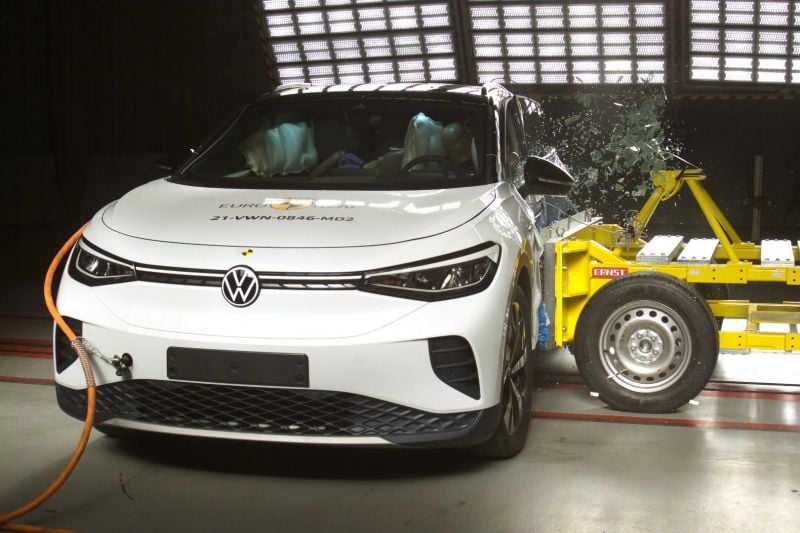
ID.4
| Category | Volkswagen ID.4* |
|---|---|
| Adult occupant protection | 93 per cent |
| Child occupant protection | 89 per cent |
| Vulnerable road user protection | 76 per cent |
| Safety assist | 76 per cent |
*Ratings apply to New Zealand-market variants only at this time
Standard safety equipment includes:
- Area View – surround cameras
- Autonomous emergency braking (AEB)
- Pedestrian detection
- Cyclist detection
- Adaptive cruise control with stop/go
- Blind-spot monitoring
- Driver attention monitoring
- Emergency assist
- Lane departure warning
- Lane-keep assist
- Parking sensors – front, rear
- Proactive occupant protection
- Rear cross-traffic assist
- Travel Assist
- Adaptive cruise control
- Adaptive lane guidance
- Traffic Jam Assist
To see how the Volkswagen ID.5 lines up against its rivals, check out our comparison tool
How much does the Volkswagen ID.5 cost to run?
VW’s new EV is covered by a five-year, unlimited-kilometre new vehicle warranty, while the high-voltage battery is warranted for eight years or 160,000 kilometres.
| Servicing and Warranty | Volkswagen ID.5 |
|---|---|
| Warranty | 5 years, unlimited kilometres – vehicle 8 years or 160,000 kilometres – EV battery |
| Roadside assistance | 2 years – standard 12 months service initiated after 2 years |
| Service intervals | 2 years or 30,000 kilometres |
| Capped-price servicing | Up to 10 years or 150,000 kilometres |
| Total capped-price service cost | $1785 – 6yr/90,000km $2350 – 8yr/120,000km $2890 – 10yr/150,000km |
Volkswagen has also committed to supporting ID owners with 10 years of battery supply from end-of-production (EOP) and 15 years of reparability from EOP. The MEB platform’s pouch cell construction also allows for individual battery modules to be repaired and replaced rather than requiring a whole new unit in the event of damage.
The company’s dealer network will also activate a Service Initiated Roadside Assistance policy for 12 months each time you take your vehicle in for scheduled maintenance at an authorised dealer.
If you get in quick, the first 500 ID.4 and ID.5 buyers will also get a complimentary AmpCharge 7kW wallbox thrown in with purchase, including installation. This is valued at $1899 and comes in several colours to match your car.
VW Australia is establishing a greater partnership with Ampol, which in future will also include charging offers for ID customers and other member perks – further details are coming soon.
To see how the Volkswagen ID.5 lines up against its rivals, check out our comparison tool
CarExpert’s Take on the Volkswagen ID.5
If you’re a keen driver, the GTX is the obvious pick between Volkswagen’s pair of new electric SUVs from launch.
The tighter tuning and more faithful response to inputs make the ID.5 GTX feels far less SUV-like in character than the ID.4 Pro, and definitely inject a dash of GTI to the driving experience for the dads and mums that need to fit the kids and the dog in the back of their VW.
Yes, it’s more expensive than the equivalent Model Y or BYD Sealion 7, but what Volkswagen (and other legacy brands) offer in this space is a very familiar driving and tech suite, the kind of refinement and reliability honed over decades of development, and an ownership and aftersales experience backed by a national dealer network.
Similar money will only buy you an entry-level rival EV from other mainstream brands like Toyota, Ford, Kia and Hyundai, and if you get in early you get a free home charger.
It’s also cheaper like-for-like than all of its VW Group stablemates – but there’s still room for improvement.
Perhaps my biggest sticking point is the ID.5 GTX’s $13,000 premium over the already well-rounded ID.4 Pro. It’s certainly not $13,000 better, even if it’s a noticeably more engaging and capable drive with better seats to boot.
At this price point the same-same cabin from said ID.4 Pro also lacks a bit of wow factor compared to the near luxury levels of presentation offered by some Chinese rivals, and EV tech buffs will lament the lack of factory connectivity even if Volkswagen’s third-party solution bridges some of that gap.
The lack of wireless Apple CarPlay and Android Auto as well as native satellite navigation with connected updates from launch may also grate, but at least the former is set to be addressed shortly after the first vehicles are delivered to customers.
All told, the ID.5 GTX is not quite the compelling package the ID.4 Pro is, so with a GTX version of the wagon-bodied model also on the way, and likely for a few thousand dollars less, that could be the mid-size VW electric SUV worth waiting for if you are wary of pulling the trigger, unless you really love the ID.5’s sleeker design.
Interested in buying a Volkswagen ID.4? Get in touch with one of CarExpert’s trusted dealers here
Click the images for the full gallery
MORE: Everything Volkswagen ID.5



